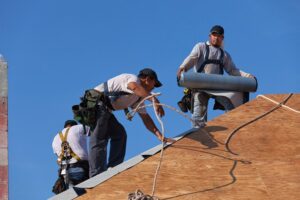
Commercial roofing replacement is an essential aspect of maintaining the integrity and functionality of your Olive Branch business. Over time, commercial roofs experience wear and tear, and it is crucial to identify the signs that indicate the need for replacement. In this article, we will discuss the importance of roof replacement, how to choose the right roofing material, the process of roof replacement, estimating costs, and hiring a professional roofing contractor.
Understanding the Need for Roof Replacement
Commercial roofs are constantly exposed to various elements, such as extreme weather conditions, UV rays, and other external factors. Over time, these factors can cause damage and deterioration, compromising the roof’s functionality. Ignoring the signs of roof damage can lead to more significant issues, such as leaks, structural damage, and decreased energy efficiency.
Furthermore, the impact of climate change has intensified the challenges faced by commercial roofs. With more frequent and severe weather events occurring, the resilience of commercial roofs is put to the test. Proper maintenance and timely replacement are crucial to ensure the long-term performance of commercial roofing systems in the face of these evolving environmental conditions.
Signs Your Commercial Roof Needs Replacement
It is essential to be aware of the signs that indicate the need for commercial roof replacement. These signs include:
- Visible cracks, splits, or missing shingles
- Water stains or leaks
- Excessive mold or algae growth
- Increased energy bills
- Age of the roof exceeding its lifespan
If you notice any of these signs, it is crucial to take immediate action to prevent further damage and protect your business.
The Lifespan of Commercial Roofs
The lifespan of a commercial roof can vary depending on various factors, including the roofing material used, maintenance practices, and weather conditions. On average, a well-maintained commercial roof can last between 20 to 30 years. However, it is essential to assess the condition of your roof regularly and consider replacement if it exceeds its expected lifespan or shows signs of aging.
Moreover, advancements in roofing technology and materials have provided opportunities to enhance the longevity and performance of commercial roofs. From eco-friendly options that improve energy efficiency to innovative designs that offer better resistance against wear and tear, businesses now have a range of choices to ensure their roofs withstand the test of time. Keeping abreast of these developments can help property owners make informed decisions when it comes to roof replacement and maintenance.
Choosing the Right Roofing Material
Selecting the right roofing material is crucial when planning a commercial roof replacement. Different roofing materials offer varying levels of durability, energy efficiency, and cost-effectiveness. It’s essential to understand the unique characteristics of each material to make an informed decision that aligns with your commercial property’s needs. Here are some additional considerations to keep in mind:
Roofing materials not only impact the functionality of your commercial building but also play a significant role in its overall aesthetics. The choice of material can enhance the architectural style of the property, contributing to its curb appeal and value. Additionally, certain roofing materials may be better suited for specific climates or weather conditions, providing better protection against elements like heavy rainfall, snow, or extreme heat.
Comparing Different Roofing Materials
There are several roofing materials available for commercial buildings, each with its own set of advantages and disadvantages:
- Asphalt Shingles: Known for their affordability and ease of installation.
- Metal Roofing: Durable and long-lasting, offering excellent protection against harsh weather conditions.
- TPO (Thermoplastic Olefin) Roofing: A popular choice for its energy efficiency and resistance to UV rays.
- EPDM (Ethylene Propylene Diene Monomer) Roofing: Highly durable and suitable for flat or low-slope roofs.
- PVC (Polyvinyl Chloride) Roofing: Known for its strength, chemical resistance, and fire-retardant properties.
Consulting with a roofing professional can provide valuable insights into the performance and suitability of each material for your specific commercial property. Their expertise can help you navigate the complexities of choosing the right roofing material that aligns with your budget and long-term goals.
Factors to Consider When Choosing Roofing Material
When selecting a roofing material, consider factors such as:
- Climate and weather conditions: Choose a material that can withstand the local climate and weather patterns.
- Budget constraints: Balance the initial cost of the material with its long-term durability and maintenance requirements.
- Maintenance requirements: Evaluate the upkeep needed to prolong the lifespan of the roofing material.
- Aesthetics and architectural style: Select a material that complements the design and enhances the overall appearance of the commercial property.
- Environmental impact: Consider the sustainability and eco-friendliness of the material to reduce the property’s carbon footprint.
By carefully evaluating these factors and seeking expert advice, you can make a well-informed decision that ensures the longevity and performance of your commercial roof.
The Roof Replacement Process
The roof replacement process involves several crucial steps to ensure a successful and efficient project.
Initial Roof Inspection and Assessment
Prior to the actual roof replacement, a professional roofing contractor will perform a thorough inspection and assessment of your existing roof. This step helps identify any underlying issues, such as structural damage or hidden leaks. Based on the assessment, the contractor will provide recommendations for the replacement process.
The Actual Roof Replacement Procedure
Once the initial inspection is complete, the roofing contractor will begin the replacement process. This typically involves removing the old roofing material, repairing any damaged substrate, and installing the new roof according to industry standards. The contractor will ensure proper insulation, flashing, and ventilation to maximize the roof’s performance and longevity.
Cost of Commercial Roofing Replacement
The cost of commercial roofing replacement can vary depending on several factors, including the size of the roof, the chosen roofing material, and any additional repairs or installations required. It is important to properly estimate the costs to budget accordingly.
Estimating the Cost of Roof Replacement
Obtaining multiple quotes from reputable roofing contractors will help in estimating the cost of roof replacement accurately. The contractor will consider factors such as labor, materials, permits, and any additional services required to provide a comprehensive estimate.
How to Budget for a Roof Replacement
When budgeting for a commercial roof replacement, consider allocating funds for the following:
- Roofing materials
- Labor and installation costs
- Permits and inspections
- Potential structural repairs
- Unforeseen expenses
Having a realistic and well-planned budget will ensure a smooth and successful roof replacement project without unexpected financial burdens.
Hiring a Professional Roofing Contractor
When it comes to commercial roof replacement, hiring a professional roofing contractor is crucial for a successful and long-lasting result.
Qualities to Look for in a Roofing Contractor
When selecting a roofing contractor, consider the following qualities:
- Experience and expertise in commercial roof replacement
- Licenses and certifications
- Positive reviews and references
- Insurance coverage
- Transparent and detailed cost estimates
By choosing a reputable and reliable roofing contractor, you can ensure that your commercial roof replacement is carried out professionally and efficiently.
The Importance of Hiring a Licensed and Insured Contractor
Hiring a licensed and insured roofing contractor provides essential protection and peace of mind. Licensed contractors have met specific requirements and demonstrate their expertise in the field. Insurance coverage protects both the contractor and you from liability in case of accidents or damages during the roof replacement process.
In conclusion, understanding the need for commercial roof replacement, choosing the right roofing material, following a well-defined replacement process, estimating costs, and hiring a professional roofing contractor are key aspects of ensuring a successful commercial roof replacement project. By addressing these factors and taking appropriate action, you can protect your Olive Branch business and maintain the integrity of your commercial property for years to come.
Ready to safeguard your Olive Branch business with a top-tier commercial roofing replacement? Look no further than Commercial Roofing Rana. With our extensive experience serving the Mid-South since 1983, we specialize in providing durable Duro-Last roofing systems, tailored to offer superior protection for your property. Whether you manage an industrial facility, a retail space, or a municipal building, our licensed team is committed to delivering exceptional quality and service. Don’t let water damage threaten your investment. Schedule Now with Commercial Roofing Rana and ensure your commercial property is equipped with the best defense against the elements.
